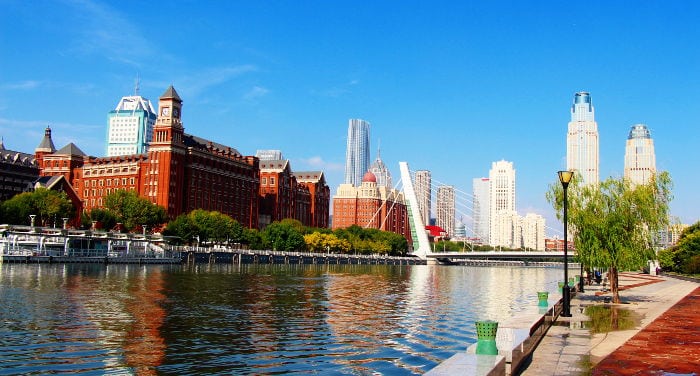
Along with Beijing, Tianjin (天津) is one of the most important cities in northern China and is the fourth most populated city in the country. The city center is located only 130 kilometers from the Forbidden City, but despite its proximity to Beijing and the significant tourist attractions that it offers, it is one of the main forgotten stops in the majority of trips around China.
Although downtown Tianjin is 50 kilometers from the coast, the city has the largest port in northern China and one of the main ports on the national level. A large portion of the city’s wealth is derived from its port, and thanks to the development of cruise ships in East Asia, it is turning into an important entry point for visitors.
During the second half of the XIX century and the beginning of the XX century, Tianjin was divided into different concessions held by the powers of the Eight-Nation Alliance. Countries such as France, the United Kingdom, Italy, Japan, Russia and the Austro-Hungarian Empire divided up the lands surrounding the Hai River, which crosses the city. Each of these countries built its own churches, schools, markets and accommodations, turning Tianjin into one of the places in the world with the most varied architecture.
The foreign occupation came to an end following the Second World War and the expulsion of the Japanese. Currently, Tianjin is a modern city in which European buildings, Japanese buildings and different examples of typical Chinese architecture from the XX and XXI centuries coexist in harmony.
When to go
Like any city in northern China, Tianjin has cold and windy winters and hot and rainy summers. Because of this, the best times to visit are between May and July and between September and November, when temperatures are less extreme.
While the months of July and August are rainy, they get more sunny days than in neighboring Beijing. Plus, the proximity to the sea moderates temperatures, which tend to be more pleasant than in the capital.
In any event, I have been able to visit the city during different times of year, and despite the temperatures, the visit during the winter was one of my favorites. Maybe it was because the cold, combined with the city’s prominent European style and abundant illumination, gave it a very Christmasy touch.
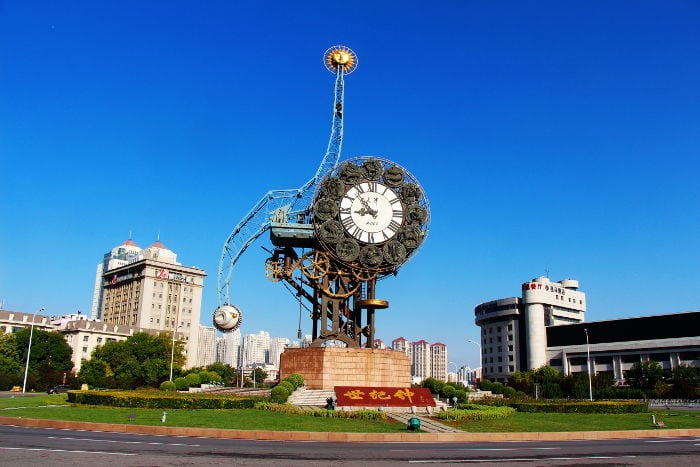 An interesting clock at Tianjin Station
An interesting clock at Tianjin Station
How to get there and getting around in the city
Given how close it is to Beijing and that it is the main seaport in northern China, Tianjin is very well-connected both on the national and international levels.
Plane
Tianjin-Binhai International Airport (天津滨海国际机场) is 17 kilometers away from downtown and has flights that connect it to the main cities in the country as well as the international airports of Southeast Asia, Japan, Korea, Russia, Australia and Europe.
The airport is well-connected to downtown and the train station through subway line 2. In addition, multiple shuttle services connect the airport to different areas of the city, and special buses 4 and 5 are also useful if your destination doesn’t have a nearby subway station.
Click here to read our guide on domestic flights in China.
Train
One of the city’s attractions is that the main train station is in the middle of downtown, which is quite abnormal in Chinese cities. Tianjin Station (天津站) connects the city to other cities in the vicinity, such as Beijing and Qinhuangdao, or others farther away such as Guangzhou, Xi’an or Shanghai. Many of the north-south and east-west railways pass through Tianjin, making it easy to get connections at any time of day.
Tianjin Station, which has been converted into a very modern facility since the arrival of bullet trains, lets you start to enjoy the city from the time you arrive, as its main entry offers exclusive views of the Hai River. In addition, it is connected to subway lines 2 and 9, and many municipal buses pass nearby it.
Tianjin West Station (天津西站) is also located near downtown and is one of the stops on the trains that connect Beijing with Shanghai, Hangzhou, Qingdao and other coastal cities. It also connects the city with the nearby Hebei province.
Click here to read our guide on traveling in China by train.
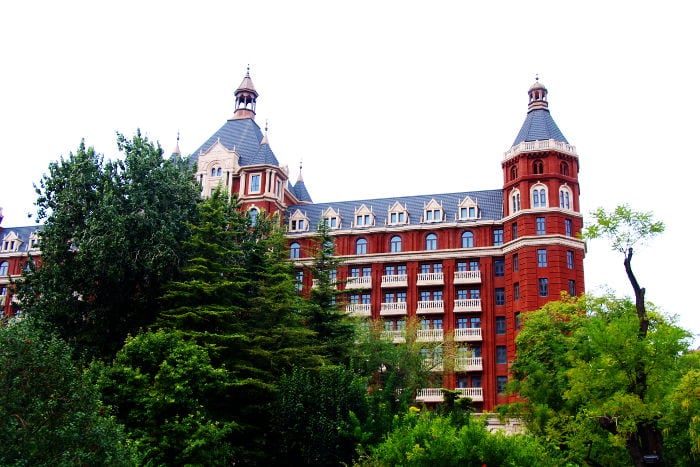 Main façade of the Ritz-Carlton hotel
Main façade of the Ritz-Carlton hotel
Boat
Tianjin has the largest artificial port in China, located in the Binhai district. While many cargo ships dock at it, it also has a passenger terminal. These ferries connect the city with Dalian and various cities in Shandong.
In addition, over the past years, it has been turning into an important stop on the numerous cruise ships that travel to the main ports in China, Korea and Japan. This stop tends to be used to visit Beijing (the majority of brochures call this stop “Beijing”). This makes it impossible for Tianjin to make the most of the large number of visitors that arrive at its port. Nonetheless, the typical duration of this stop, which is one or two days, would be perfect to take the opportunity to visit Tianjin.
The best way to get downtown from the port is through subway line 9, which will drop you off at the train station. Because of this, this is also the most recommendable way to go from the port directly to Beijing.
To get around downtown, the subway is very convenient, as lines 2 and 9 have stops at the main tourist attractions in the city. Plus, if you have access to one of the many bike rental services that are prospering in China, this would be the most convenient way to get around.
Where to stay
Tianjin’s economic and cultural development over the past two decades has been accompanied by the establishment of numerous hotels. The city’s downtown has a large variety of accommodations, ranging from 5-star hotels to more modest hostels.
In addition, in the historical area of the Five Great Avenues, which I will discuss in more detail below, some historical residences have been outfitted as boutique hotels.
Given that Tianjin is a city that can be visited in one or two days and that it is very well-connected with Beijing, it’s also very convenient for doing single day return trip excursions.
Click here if you would like to see the hotels that we recommend in Tianjin.
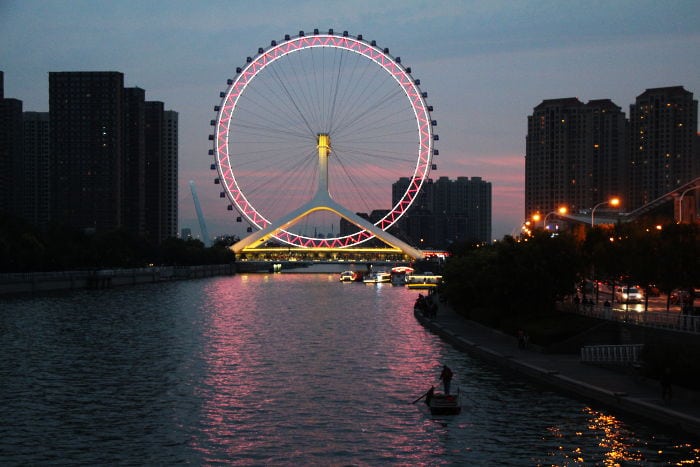 Sunset views from Jingang Bridge, with the Tianjin Eye in the background
Sunset views from Jingang Bridge, with the Tianjin Eye in the background
What to do in Tianjin
Tianjin is a perfect spot for a one-day excursion from Beijing or to spend the weekend. It is a highly-varied city with a prosperous cultural scene.
One of my favorite parts of the city is the boardwalk along both sides of the Hai River. This path runs along the entire city, from Tianjin’s Ferris wheel almost up until the river’s mouth, and offers a practically unique opportunity in China for walking. Taking advantage of the fact that the city is crossed by this river, I will present the main tourist destinations by following the river from north to south, although by no means do you have to follow this order.
The “Tianjin Eye” Ferris wheel (天津之眼), located over the river like a bridge, is one of the most recognizable modern symbols of Tianjin. This large 120-meter high structure offers an exclusive place to view the city’s span to the north as well as the river’s path through the city. At sunset, when it is lit up, it’s a spectacular sight to see, especially from Jingang Bridge (金钢桥).
Not very far away, 600 meters to the south of the Ferris wheel on the western bank of the river is the cultural street Gu Wenhua Jie (古文化街). Like many similar areas in China where traditional architecture is represented, the majority of the street now consists of modern buildings. There’s only one original pagoda, but in the street’s defense, I would say that it’s one of the most appealing cultural streets in the country. While it can’t quite compete with Shanghai’s Old Street or Qianmen in Beijing, Wenhua Jie has a different touch. Many of its stores are traditional and filled with antiques, jade, and the artisan production of local products.
It’s worthwhile to move around on foot or bicycle along the river to the south and to cross Fu’an Bridge (福安桥) up until Italian Style Town. This route covers approximately 1.5 kilometers. Fu’an Bridge is decorated with golden statues, and despite being modern, has a French touch that aims to imitate Pont Alexandre III in Paris.
The former Italian Concession, which has currently been converted into a pleasant Little Italy with coffee shops, plazas and street vendors, is the perfect place to stop, and if the weather is willing, to drink a good coffee on a patio. Only a very few buildings are actually reminiscent of Italy; except for a few statues and the Venetian façade of Plaza Marco Polo, the majority of the buildings stand out more for the stores and restaurants that they hold than for their exteriors.
On the other bank of the river is the city’s downtown in a more traditional sense. A series of pedestrian streets crossed by the commercial Binjiang Road (滨江道) are the perfect place to find snacks, clothing stores, and some of the city’s architectural jewels.
Quanye Bazar (劝业场) was one of the first large warehouses in China and today has once again been converted into the best place to find the top national and international brands. It is located on the corner of Binjiang Street and Heping Street, and even though its name is only in Chinese, you will recognize it because it is on the corner opposite a large Zara store.
At the end of Bijiang Street is the Catholic Cathedral of Tianjin (天主教西开总堂), built by the French out of red brick and ornately decorated inside. In addition, while passing through the area, don’t miss the skyscraper that emulates the Empire State building in New York, another one of the city’s eccentricities.
Only a 10-minute walk from the cathedral is Jingyuan (静园), the residence of the last emperor of China during the years following his deposition. He lived there while dressing and eating like a European, awaiting the restoration of the monarchy. In this house-museum, you can learn not only about the life of the emperor and his wife and concubines, but also about the lifestyle of the upper-class in European Tianjin at the beginning of the XX century.
The last building that I wanted to highlight around Binjiang Street is the Porcelain House (中国瓷房子), an eye-catching residence decorated with thousands of porcelain pieces in the most faithful Gaudí style, dragon statues and stained-glass. I wouldn’t go so far as saying that I liked it or thought it was a monstrosity, but what’s for certain is that it’s worth visiting, even if just to see the outside. Going inside costs 35 Yuan and it is worth it.
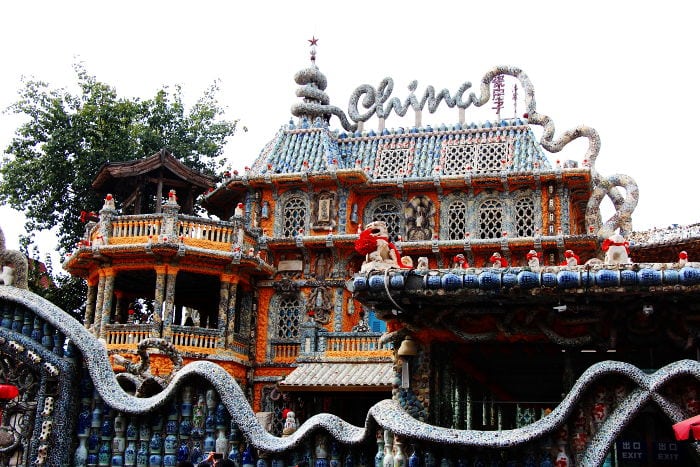 Visits to the ornate façade of the Porcelain House
Visits to the ornate façade of the Porcelain House
Returning to the river, I wanted to highlight the large number of European buildings located on Dagu North Road (大沽北路) and the western bank of the river to the south of the train station.
Many of these are currently bank headquarters, hotels and government buildings, which makes it easy for me to tell you which were my favorites. Following Jiefang Bei Street (解放北路), I would recommend the Russian Japanese Bank, the Ritz-Carlton and Astor hotels and the Concordia Club. They were all built at the beginning of the previous century and at the time were the most prominent the buildings in the city, demonstrating the economic power of the French and English armies stationed there at the time.
I would recommend that you take your time in this area, letting yourself be swept away by the many buildings that will catch your eye during the walk, as there are so many examples of French, English and Austrian architecture scattered throughout the area, to the point that they could make this guide excessively long.
The last area that I want to highlight in Tianjin is that surrounding the Five Great Avenues (五大道), which takes its name from the five main streets that make it up, and which during its time was one of the most exclusive areas in the city. Many local and foreign leaders built their homes here, many of which are still in a perfect state and have been converted into boutique hotels.
These streets, which are about 2 kilometers long, have many cafés, parks, a large theater and an interesting open stadium with a track and field court. Around the stadium are numerous restaurants and some of the best buildings in the area.
Out of the five avenues that make up the area, the ones that I liked the most were Changde Dao (常德道) and Munan Dao (睦南道), although it’s better to let yourself go and follow the pretty tree-lined sidewalks. This would be one of the best parts of the city to visit by bicycle, considering that there isn’t much traffic and its abundant shade makes moving around on bicycle very pleasant.
Last of all, to the south of the Five Great Avenues and if you have time left, I recommend a short visit to Tianjin Foreign Studies University (天津外国语大学). It has multiple buildings that strictly follow the style of British universities, and is considered one of the most beautiful universities in China.
As you can see, Tianjin has a great architectural wealth and as opposed to other cities that you will see in China, it barely has any visits that you have to pay to enter, which makes it a very cheap option for a day trip from Beijing.
Every time that I have gone to Tianjin, I’ve discovered new areas and am sure that there will be many more buildings and neighborhoods that I will be able to tell you about in future updates.
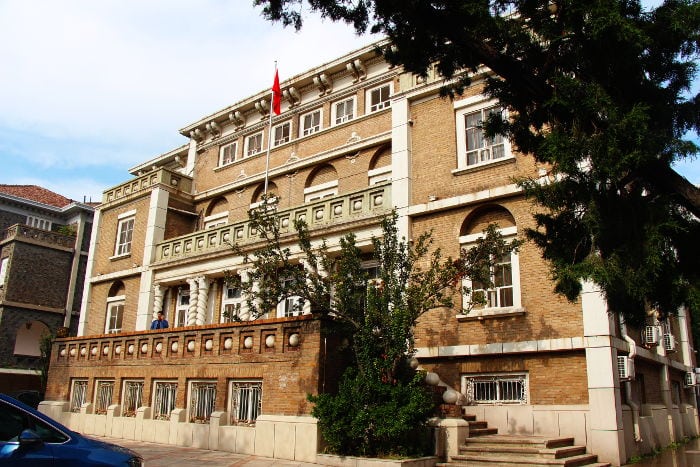 Residence on the Five Great Avenues
Residence on the Five Great Avenues
What to eat in Tianjin
As opposed to other Chinese cities, Tianjin isn’t particularly known for its cuisine, which is quite similar to that of Beijing. Like any large city, it has many restaurants that offer the best types of cuisine from the country, so you won’t have any problems with food.
Its most famous product is mahua (麻花), a braided and fried dough that is normally topped with dried fruit, sesame or sugar. It’s extremely crispy, which for me is one of its best features.
The city’s most famous restaurant is Goubuli (狗不理), which became renowned for its baozi, the dough of which has a slight puff-pastry touch to it. It is located in an old building near Binjiang Street and despite its high price (70 Yuan for a plate of baozi), it’s worth visiting because of its originality and historical value.
One place where I enjoyed eating was Kaifeng Street (开封路), which is close to the Five Great Avenues. This street is home to numerous restaurants, the majority of which offer food from southern China, as well as a large variety of snacks, making it perfect for a quick stop. A famous snack in Tianjin (although you can find it in all of China) are Chinese crepes, or jiangbing guozi (将饼果子).
Tianjin is also famous for its seafood restaurants, which tend to be quite affordable. It’s worth trying them if you have a bit of time.
Photo Credits: Photos by Nacho Garcia



